13-inch Retina MacBook Pro Review (Late 2012)
by Anand Lal Shimpi on November 13, 2012 2:53 AM ESTThermals & Acoustics
When we looked at the 15-inch rMBP we noted that it was a significant improvement in the thermal department compared to the previous, 2011 MacBook Pro. The move to 22nm Ivy Bridge and 28nm Kepler silicon meant a much better power profile than the outgoing model. Apple also changed the way it brings air through the system. The previous MacBook Pro chassis did all air exchanging through vents near the hinge of the machine. The new Retina systems pull in cool air from the sides and exhaust it at the display hinge.
In the 15-inch rMBP the improved cooling combined with more power efficient silicon helped ensure more consistent performance over time. While the 2011 15-inch MacBook Pro would quickly throttle under heavy CPU and GPU load, the 15-inch Retina MBP didn't have to reduce clock speeds as aggressively to keep the system's thermal footprint in check.
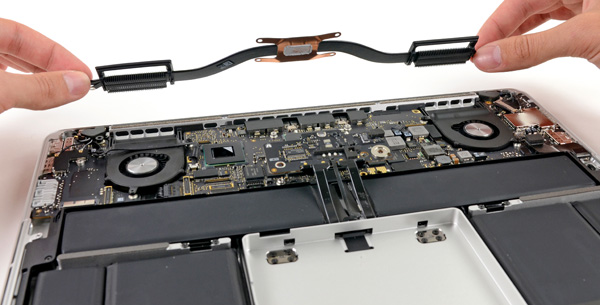
13-inch rMBP cooling solution, courtesy iFixit
With the 13-inch model, the cooling problem is far less of an issue. For starters, Apple only has to remove heat from a single major producer rather than two. There is no discrete GPU in the 13-inch rMBP, so the cooling workload is immediately reduced. Secondly, the 13-inch rMBP is only available with a dual-core 35W Ivy Bridge processor, and not the quad-core 45W parts used in the 15-inch model. With a cooler running CPU and no dGPU, the 13-inch rMBP has a much easier job of staying cool compared to the 15.
To confirm there was no obvious CPU throttling I ran two tests. The first was continuous runs of Cinebench 11.5's multithreaded render benchmark. Prolonged multithreaded FP workloads have always been a great way to drive temperatures up. We didn't see any throttling during this test on the 15-inch rMBP, and it's no surprise that we see no different here with the 13-inch model:
Next up, I ran the same type of test but using Half Life 2 instead. Here I picked settings that provided a good balance of CPU and GPU workload and ran back to back timedemos while monitoring performance:
As expected, there's no obvious drop in performance over time.
Apple also paid attention to acoustics with this generation. Like the 15-inch model, the 13-inch rMBP uses two fans to remove heat from a single heatpipe that runs across the CPU. The fan blades are asymmetrically spaced on each fan to produce a sound that's more varied across the frequency spectrum, rather than concentrated at specific frequencies. The idea is to create the illusion of quiet fans without negatively impacting cooling ability.
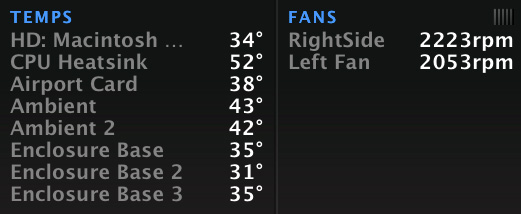
Even more so than in the 15-inch rMBP, Apple's fans in the 13-inch rMBP rarely spin above 2200 RPM. During both the Cinebench and Half Life 2 tests, fan speed remained around 2100 RPM. At these speeds, fan noise is effectively non-existent. In fact, during all of my testing of the 13-inch rMBP there were only a couple of times when I actually heard the fans spin significantly faster than that. Although I would like to see faster silicon and dGPU-level graphics performance in the 13, the obvious benefit of not having four cores and discrete graphics is a very quiet system.
Thermal performance goes hand in hand with acoustics of course. During the Half Life 2 marathon run I kept tabs on CPU and chassis temperature. The results are below:
| Thermal Comparison | ||||
| 13-inch rMBP | 15-inch rMBP | |||
| Max CPU Temp | 52C | 63C | ||
| Max GPU Temp | - | 72C | ||
| Max Surface Temperature (Top) | 48.1C | 49.8C | ||
| Max Surface Temperature (Bottom) | 41.6C | 41.8C | ||
Unfortunately I don't have a 2011 13-inch MacBook Pro to compare to, but the 13-inch rMBP is clearly cooler running than the 15. In terms of user experience, I felt the 13-inch rMBP get warm but never too hot to use on my lap.


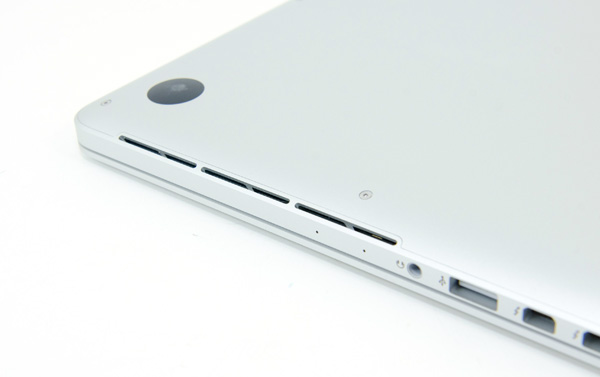
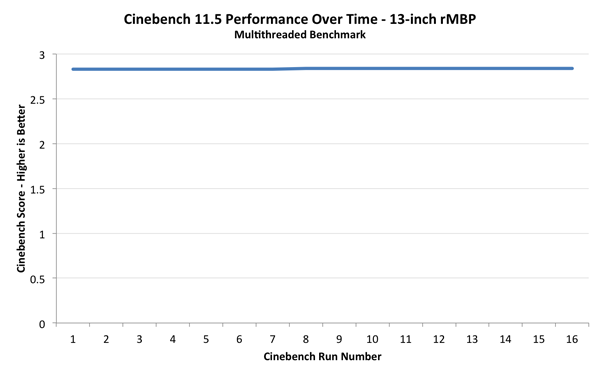
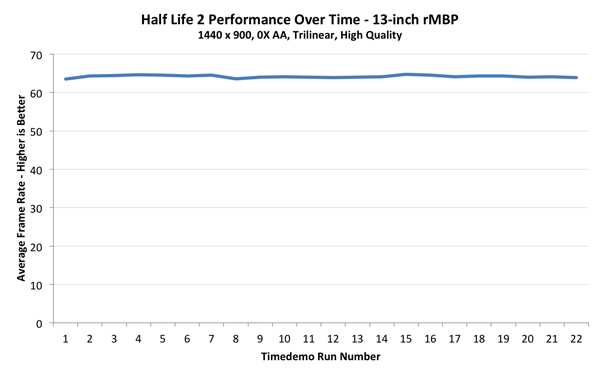








79 Comments
View All Comments
Spunjji - Tuesday, November 13, 2012 - link
As of a few days ago Adobe updated Lightroom to include Retina support in the Develop window. That means the UI will scale while the image remains at a 1 for 1 pixel mapping and is unaffected by scaling.piroroadkill - Tuesday, November 13, 2012 - link
In your chart noting the different screen ratios, you have Retina MacBook Pro under 16:9 - clearly incorrect, 2560x1600 and 2880x1800 for the 13 and 15 inch respectively are 8:5 ratios (16:10 in common terms).Beerfloat - Tuesday, November 13, 2012 - link
A MacBook Pro needs a GPU, period. Sure, performance of the Intel solution is getting stronger, and may soon reach parity on the low end. But more importantly, the mature driver and ecosystem that Nvidia brings will still be an advantage for some generations to come.This kind of corner cutting is almost acceptable in the Air. But not in a Pro.
Spunjji - Tuesday, November 13, 2012 - link
Agreed. Shame, but definitely a compromise too far.mayankleoboy1 - Tuesday, November 13, 2012 - link
" I definitely noticed the missing cores (and decrease in clock speed compared to the higher spec'd 15),"What are you doing that makes use of 4 real cores ? And is the 200mhz speed difference really noticable ?
I would say that in normal surfing+office apps, a SSD would make all the differences between CPU redundant...
jramskov - Tuesday, November 13, 2012 - link
Lightroom would be one answer.mayankleoboy1 - Tuesday, November 13, 2012 - link
But does Anand even use it ? Regularly ?tipoo - Friday, December 7, 2012 - link
Why would someone buy this for "surfing+office apps"? It's meant to be a machine for professionals and high end users, hence Pro.smurray - Tuesday, November 13, 2012 - link
What app is being used to measure the FPS of the UI during things like Safari scrolling? I currently have an 13" rMBP w/ the upgraded i7 CPU and am curious what my results would be compared to what was experienced in the review.Ryan Smith - Tuesday, November 13, 2012 - link
For instantaneous tests like Safari (where you see the speedometer-styled FPS indicator), we use Quartz Debug. For average framerates over a period of time we use the GL Injection Tool.